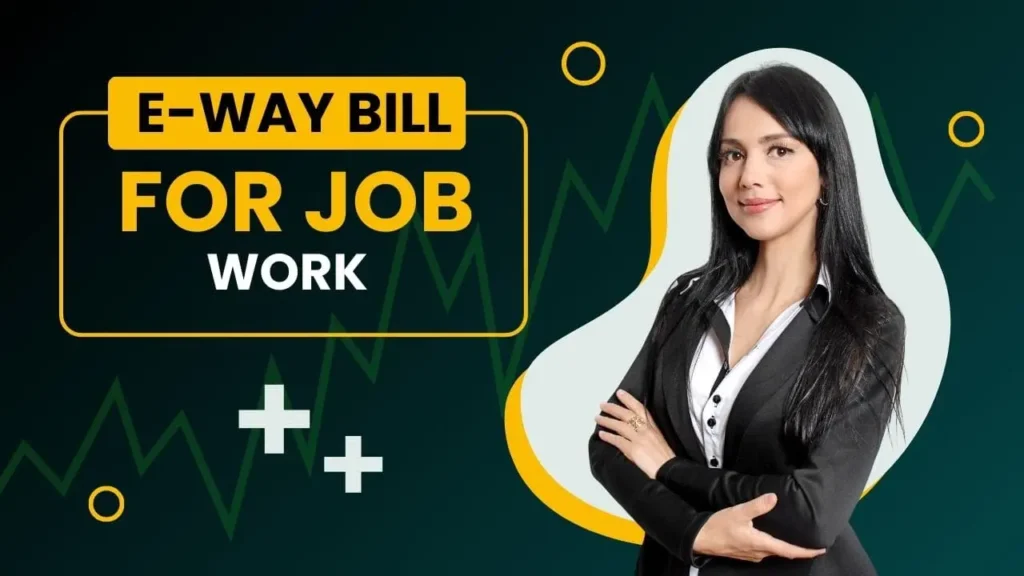This forms the basis of the Indian Goods and Services Tax regime, which has its key component as the E-way Bill system for easy transportation of goods from one state to another with a minimum number of opportunities for tax evasion. Whether you are a small business owner, truck driver, or just interested in logistics and supply chain management, this system should be understood. The distance limit is one of the more confusing elements in this extensive list of rules and regulations. What distance can be covered under an E-way Bill? Here, we will talk about what the E-way Bill distance limit actually is, its impact on the transportation sector, and answers to many frequently asked questions that will help you better deal with this important aspect under the GST regime.

What is an E-way Bill?
This is not in the list, but let us briefly talk about what is meant by an E-way Bill. An E-way Bill, short for Electronic Way Bill, is a document generated on the GST portal for the movement of goods worth above ₹50,000 from one place to another. This, in itself, is a digital mechanism to ensure that the goods under movement are tracked by the GST authorities, bringing to an end the evil of tax evasion. It will include details such as
- Transporter details
- Consignment details (goods being transported)
- Supplier and recipient details
- Place of origin and destination
Without an E-way Bill, goods can’t legally be transported across state borders, and penalties for non-compliance can be severe.
E-way Bill Distance Limit: Explained
One of the important aspects of the E-way Bill is the distance limit, which essentially refers to the validity of the bill in terms of the distance goods can travel.
How Does the Distance Limit Work?
The E-way Bill system operates based on a fixed kilometers-per-day rule. As of the latest updates:
- For a vehicle traveling by road, the bill is valid for 1 day for every 200 kilometers (km) or part thereof.
- If the distance between the supplier and recipient’s location exceeds 200 km, the validity extends accordingly—1 day for every 200 km.
For example:
- If the distance between the source and destination is 150 km, the E-way Bill is valid for 1 day.
- For a distance of 350 km, the bill will be valid for 2 days.
The system ensures that transportation of goods is completed within a reasonable time frame, and extensions to the validity period can only be applied for under specific circumstances.
Why is the Distance Limit Important?
The distance limit plays a crucial role in ensuring the timely and transparent movement of goods across the country. Here’s why it’s important:
- Prevents Malpractices: It helps prevent unauthorized diversion of goods to locations other than the one mentioned in the bill.
- Encourages Efficient Transportation: The distance limit ensures that transporters and businesses plan their logistics efficiently, reducing delays and misuse of the system.
- Monitors Goods Movement: It allows GST authorities to monitor goods in transit, reducing opportunities for tax evasion.

Also Check:
Validity of E-way Bill and Extensions
As mentioned, the validity of an E-way Bill depends on the distance to be covered:
- Up to 200 km: Valid for 1 day
- 201-400 km: Valid for 2 days
- 401-600 km: Valid for 3 days
- And so on…
But what if the transportation takes longer due to unforeseen circumstances like roadblocks, vehicle breakdowns, or natural disasters?
Extension of Validity
The GST portal permits an extension of E-way Bill if the valid reasons have caused the transporter to fail to complete the journey within the validity period. But this must be requested before the expiry of the original E-way Bill.
For example:
The transporter can get the extension if the goods are stuck due to a flood or vehicle malfunction; this has to be applied for while the bill is valid.
Once such an E-way Bill is issued, it may be made available for a more extended period of time as demanded by the journey.
Common Challenges with the Distance Limit
While the E-way Bill distance limit brings about transparency, it can also present challenges for businesses:
- Delays Due to External Factors: Transport delays caused by bad weather, strike, or vehicular breakdown may even be over the valid period of an E-way Bill. In such instances, if not renewed in time, then appropriate penalties would be charged on the bill.
- Inaccurate Distance Calculation: The verification period of the bill can become an incorrect period, so that the distance between two places may become impossible to be estimated. The consequences include non-compliance.
Handling Multiple Shipments: Businesses handling multiple shipments simultaneously need to keep a close eye on the validity of each E-way Bill, adding to administrative complexity.
Conclusion
The distance limit in the E-way Bill system is, therefore, an imperative understanding for the givers and takers of goods within India. It does not only include total transparency and accountability but also harbors logistics and reduces the chances of tax evasion. Yet, it asks for a need to meet the latest rules and regulations to avoid penalty.
With proper distance calculation, proper logistics planning, and further ensuring application in case of extension, it would ensure smooth and compliant transportation of goods under E-way Bill.
The updates of the laws related to GST regarding the E-way Bill shall be followed as such changes may influence the distance limit and other aspects of the E-way Bill system.
Also Check:
- What is an E-way Bill GST? And why do you need it?In the complex world of logistics and taxation, the E-way Bill under the GST system has become a crucial element for businesses engaged in the transportation of goods across India. It is basically a document mandated by the government to… Read more: What is an E-way Bill GST? And why do you need it?
- E-Way Bill for Job Work: A Comprehensive GuideIf you are a manufacturer, job worker, or businessman, you might already be aware of the e-way bill system under the GST regime. For instance, the movement of goods worth a specified amount requires an e-way bill, which is one… Read more: E-Way Bill for Job Work: A Comprehensive Guide
- E-way Bill Distance Limit: Everything You Need to KnowThis forms the basis of the Indian Goods and Services Tax regime, which has its key component as the E-way Bill system for easy transportation of goods from one state to another with a minimum number of opportunities for tax… Read more: E-way Bill Distance Limit: Everything You Need to Know
- Understanding Tax InvoicesTax invoices are critical documents in the field of commerce and taxation. They serve as proof of transaction and facilitate tax compliance for both sellers and buyers. In India, the introduction of the Goods and Services Tax (GST) in July… Read more: Understanding Tax Invoices
- Blocked e-Way Bill Holding You Back?The e-Way Bill system is a crucial factor for the smooth flow of commodities in India. However, in certain situations, the GST rules will block an e-Way Bill even though an error did not originate from the physical movement of… Read more: Blocked e-Way Bill Holding You Back?
Frequently Asked Questions
What happens if my E-way Bill expires before the delivery is completed?
If your E-way Bill has been issued for a period but expires before your goods reach their destination, technically you are breaking the law. The officials may fine you and can even seize your merchandise. However if there is due to some forced circumstances, then you can claim an extension before the bill expires.
Can I extend an E-way Bill after it has expired?
No, if an E-way Bill is issued and goes dormant due to lapse, it cannot be renewed. It has to be applied for before the bill itself expires. If there are pending delays, then they advise well in advance to apply for an extension.
How do I calculate the distance for an E-way Bill?
Distance: You can enter the source and destination pin code in the GST portal to calculate the distance between them. The system will automatically calculate the distance between the source and the destination location, which will determine the validity of the E-way Bill.
What is the consequence of entering an incorrect distance in the E-way Bill?
In case there is a mistake in the distance entered during the generation of the E-way Bill, it may lead to a problem with the validity period. For instance, in case the distance is under-estimated, there could be instances where the bill expires prior to the delivery of the goods, imposing penalties on account of the same.
Can I generate multiple E-way Bills for the same consignment?
No, more than one E-way Bill cannot be generated for one consignment. Once an E-way Bill is generated for a consignment, it shall be effective for that particular journey only. However, in case of a vehicle breakdown or change of transporter, updates may be done on the existing E-way Bill.
Does the distance limit apply to all modes of transportation?
No, the distance limit rule is applicable only for road-based transportation. For air-based rail or sea-based transport modes, the E-way Bill is valid with respect to the logistics and documents accompanying such transport modes.
What should I do if my vehicle breaks down during transit?
This also allows you to update vehicle details on the E-way Bill on the GST portal, in case your vehicle breaks down. This way, the journey can proceed without having to get an all-new E-way Bill in this situation. Make sure to do this before the expiry date of the bill.
Is there a penalty for traveling without an E-way Bill?
The transportation of the commodities without a valid E-way Bill may attract heavy fines. The amount of fine for the transportation of the commodities without a valid E-way Bill is always more than ₹10,000 or the tax amount due.
How is the distance determined for generating the E-way Bill?
The distance is computed through the origin and destination pin codes. There is an inbuilt mechanism of the GST portal that computes the distance between the two pin codes based on which an estimate of the travel distance can be availed.
Can I split the consignment and generate separate E-way Bills for each part?
The next thing is that you can have different E-way Bills for every vehicle into which the consignment is split. Provided that a valid E-way Bill accompanies each part of the consignment in transit, you can split the consignment across multiple vehicles.








